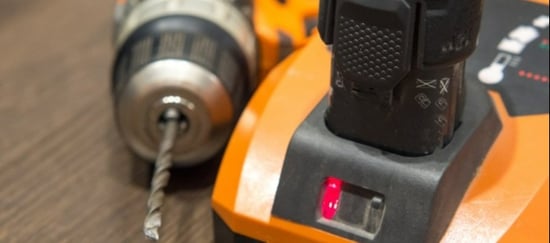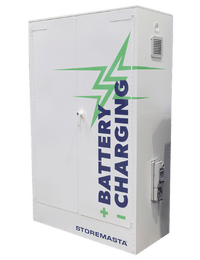While you may have heard of a battery charging cabinet, you may not be completely sure what exactly it is — or why you’d need one in your workplace. Just like any type of safety cabinet that’s manufactured to store a specific class of dangerous goods, battery charging cabinets are designed to keep your supplies of Class 9 lithium-ion batteries in a safe, controlled environment. In this blog, we’ll be answering the question, ‘What is a battery charging cabinet?’ and highlighting the various reasons you may consider installing one in your own workplace.
Battery Cabinets
Battery charging cabinets are a type of safety cabinet that’s designed especially for lithium-ion batteries. Over the recent years, as the prevalence of lithium-ion batteries has grown in workplaces, battery cabinets have become more popular due to the many risk control measures that they provide.
The key risks associated with lithium-ion batteries include:
- Thermal runaway – this process occurs when an overheated battery cell results in an exothermic explosion
- Fire & explosion – lithium-ion battery fires and explosions can occur if batteries are subject to the wrong handling practices or storage conditions
- Battery leaks – flammable electrolyte spills and leaks can affect people, property and the environment and must be contained and managed
Generally, battery cabinets provide the dual feature of safe charging and storage for lithium-ion batteries. Cabinets are equipped with an in-built electrical system that features multiple power points for battery charging within the closed cabinet.
In terms of storage, cabinets are usually constructed from sheet steel, with an acid-resistant powder coating. Features may include close-fitting, lockable doors, steel shelving and a spill containment sump to contain any battery acid leaks or spills. The cabinet’s key risk control measures include temperature regulation, in the form of natural and/or mechanical ventilation systems, that help keep the lithium-ion batteries cool and dry while they’re charging and in storage.
Battery cabinets are a type of safety cabinet specifically constructed for lithium-ion batteries.
When Should You Consider a Battery Charging Cabinet?
Many workplaces can benefit from the risk control measures provided by battery charging cabinets. You may wish to consider investing in a battery cabinet if:
Your Workplace Relies on Lithium-Ion Batteries
There are an ever-growing range of products that rely on lithium-ion batteries as a rechargeable energy source. From forklifts and delivery vehicles to industrial robots and medical devices, there are many applications for lithium-ion batteries in the workplace. Almost every industry in Australia will have some equipment, device or technology that requires this type of power source. So, it’s reasonable to consider how the handling, charging and storage of your lithium-ion batteries can impact the safety of your organisation.
Like to know more about controlling battery risks?
A few lithium-ion batteries in an air-conditioned office may be quite easy to monitor and control. However, if you have a busy workplace with multiple lithium-ion batteries, they can be subject to improper handling and environmental conditions.
When organisations are storing and charging lithium-ion batteries in their daily operations, there are many safety factors to consider. These include:
- Protecting batteries from misuse and impact damage
- Identifying and discarding old, damaged or leaking batteries
- Monitoring supplies by keeping batteries in a dedicated storage space
- Ensuring that batteries are not overcharged
- Containing and cleaning up any battery acid spills
The Ambient Temperature is Elevated
Perhaps one of the most important considerations for battery storage is to maintain a temperature-controlled environment that actively reduces the risk of thermal runaway.
Thermal runaway is the process when elevated temperatures produce an exothermic decomposition of the battery cell, resulting in instability, fire and explosion. While thermal runaway can affect a single battery cell, the risks increase if multiple batteries are stored nearby. With one battery overheating the next, a domino effect of cascading thermal runaway can occur. This only increases the intensity, reach and devastation of a lithium-ion battery fire or explosion. Therefore, it’s very important to have a regulated storage facility in your workplace to store and charge lithium-ion batteries.

Thermal runaway in lithium-ion batteries can result in devastating fires and explosions.
The ambient temperature of your workplace has a direct effect on the temperature within the lithium-ion battery cell. It’s crucial that lithium-ion batteries are stored in a cool, dry environment.
If you note the battery manufacturer’s instructions, you will find specific information relating to the hazards associated with these energy sources.
In a country such as Australia, that has a notoriously hot and humid climate, it’s likely that you will require temperature controls for your battery stores. Extreme heat will not only negatively affect the performance and power capabilities of your lithium-ion batteries, it will increase the risk of thermal runaway, fire and explosion in your organisation.
Risk control measures that should be considered for your battery store may include:
- Temperature controlled environment
- Natural or mechanical ventilation
- Fans to disperse hot air
- Stores constructed with a thermal air barrier
- No direct sunlight
- Located away from ignition sources and hot work
Fire Suppression
One of the fundamental issues with lithium-ion batteries is their susceptibility to heat. That means that batteries kept at an elevated temperature – whether it’s in a hot car, in full sunlight, near a workplace heat source or even left outdoors – the battery can sustain permanent damage and create a fire risk for your organisation.
Due to the sensitivity of lithium-ion batteries, heat sources must be eliminated from any storage areas and ambient temperatures must be controlled. However, what would happen if a fire broke out while your batteries were in storage or charging?
Battery cabinets are equipped with fire suppression features to slow down the spread of heat and flames. These features may include a durable sheet steel construction, thermal air barrier between walls, and close-fitting doors.
The fire suppression features assist in two ways: helping to contain a fire that may break out within your closed cabinet and protecting your batteries from heat and ignition in the event of a workplace fire.
You Want to Reduce the Risks Associated with Charging
As lithium-ion batteries have been known to ignite when being recharged, it’s important to have a charging station that is free from faults and electrical malfunctions.
Battery cabinets are constructed to have intrinsically safe electrical work that reduces the risks associated with recharging. If you’re purchasing a battery cabinet, look for a model that’s been electrically certified to Australian standards. This will ensure that your electrical work meets national safety standards.
You should also never use a battery charger that is damaged, coiled or otherwise unsafe for use. Before buying a battery charger to go in your cabinet, check the packaging on your battery charger to ensure that it meets Australian safety regulations. Many battery chargers don’t meet these standards and can increase the risk associated with lithium-ion battery recharging.
Your Batteries are Often Lost, Stolen or Damaged
Battery cabinets are a convenient storage solution that encourages staff to maintain the correct handling and storage procedures. By charging and storing batteries in the one location, you are reducing the likelihood of batteries being lost, stolen, damaged or left in unsafe conditions (such as outdoors).

To reduce risk, lithium-ion batteries should be stored in a cool, dry and secure environment within the workplace.
If batteries aren’t handled, charged and stored in the correct way, it can increase risk. For example, dropping a battery or leaving it in a hot location can result in irreversible damage to the battery cell, which can lead to ignition or explosion. Providing a battery cabinet can reduce these risks by encouraging safe handling and storing practices within your team.
You should also make sure that your battery cabinet is clearly marked with the correct safety signage, so staff know where to keep your lithium-ion batteries. Having safety signage on your cabinet also alerts staff and emergency services to the hazards associated with the stored goods.
How are You Charging and Storing Your Lithium-Ion Batteries?
Thermal runaway, which can quickly affect whole stores of lithium-ion batteries, can result in devastating fires and explosions. Therefore, if you are working with lithium-ion batteries, you must always follow the manufacturer’s instructions — and keep batteries in a safe, stable and controlled environment that reduces risk. If you choose to store your lithium-ion batteries in a battery cabinet, it’s important to ensure that it’s been installed, used and maintained in the correct way. Make sure your cabinet is installed away from heat and direct sunlight and that it remains free from clutter and battery acid spill. Also remember to maintain your stores of lithium-ion batteries and immediately discard any batteries that are aged, leaking, swollen or damaged.
To find out more about reducing risk in your workplace, you can access our free eBook. Our Guide to the Safe Charging and Storage of Lithium-ion Batteries can help you handle, store and maintain your lithium-ion batteries so you can minimise risk in your organisation. Get your own copy of our eBook for free today by clicking on the image below.

Living life by the 4 C’s of marketing – communication, coffee, compliance… and more coffee – Leisa Andersen is Storemasta’s Content Marketing Manager. When she’s not writing, you’ll find her enjoying all the good things in life, including shopping, travel and gluten free donuts.

